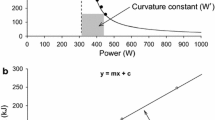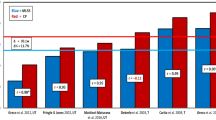Summary
The basis of the critical power concept is that there is a hyperbolic relationship between power output and the time that the power output can be sustained. The relationship can be described based on the results of a series of 3 to 7 or more timed all-out predicting trials. Theoretically, the power asymptote of the relationship, CP (critical power), can be sustained without fatigue; in fact, exhaustion occurs after about 30 to 60 minutes of exercise at CP. Nevertheless, CP is related to the fatigue threshold, the ventilatory and lactate thresholds, and maximum oxygen uptake (V̇O2max), and it provides a measure of aerobic fitness. The second parameter of the relationship, AWC (anaerobic work capacity), is related to work performed in a 30-second Wingate test, work in intermittent high-intensity exercise, and oxygen deficit, and it provides a measure of anaerobic capacity. The accuracy of the parameter estimates may be enhanced by careful selection of the power outputs for the predicting trials and by performing a greater number of trials. These parameters provide fitness measures which are mode-specific, combine energy production and mechanical efficiency in 1 variable, and do not require the use of expensive equipment or invasive procedures. However, the attractiveness of the critical power concept diminishes if too many predicting trials are required for generation of parameter estimates with a reasonable degree of accuracy.
Similar content being viewed by others
References
Bar-Or O. The Wingate anaerobic test: an update on methodology, reliability, and validity. Sports Medicine 4: 381–394, 1987
Bulbalian R, Wilcox AR, Darabos BL. Anaerobic contribution to distance running performance of trained cross-country athletes. Medicine and Science in Sports and Exercise 18: 107–113, 1986
Carnevale TJ, Gaesser GA. Effects of pedaling speed on the power-duration relationship for high-intensity exercise. Medicine and Science in Sports and Exercise 23: 242–246, 1991
Coast JR, Welch HG. Linear increase in optimal pedal rate with increased power output in cycle ergometry. European Journal of Applied Physiology and Occupational Physiology 53: 339–342, 1985
deVries HA, Moritani T, Nagata A, Magnussen K. The relation between critical power and neuromuscular fatigue as estimated from electromyographic data. Ergonomics 25: 783–791, 1982
deVries HA, Tichy MW, Housh TJ, Smyth KD, Tichy AM, et al. A method for estimating physical working capacity at the fatigue threshold (PWCFT). Ergonomics 30: 1195–1204, 1987
Gaesser GA, Brooks GA. Muscular efficiency during steady-rate exercise: effects of speed and work rate. Journal of Applied Physiology 38: 1132–1139, 1975
Gaesser GA, Carnevale TJ, Garfinkel A, Walter DO. Modeling of the power-endurance relationship for high-intensity exercise. Abstract. Medicine and Science in Sports and Exercise 22: S16, 1990
Gaesser GA, Wilson LA. Effects of continuous and interval training on the parameters of the power-endurance time relationship for high-intensity exercise. International Journal of Sports Medicine 9: 417–421, 1988
Ginn EM, Mackinnon LT. The equivalence of onset of blood lactate accumulation, critical power and maximal lactate steady state during kayak ergometry. Abstract. Proceedings of the First IOC World Congress on Sport Sciences, p. 34, Colortek Printing, Colorado Springs, 1989
Henry FM. Prediction of world records in running sixty yards to twenty-six miles. Research Quarterly 26: 147–158, 1955
Hill AV. The physiological basis of athletic records. Scientific Monthly 21: 409–428, 1925
Hill DW, Rose LE, Smith JC. A method to ensure the accuracy of estimates of anaerobic capacity derived using the critical power concept. Abstract. Medicine and Science in Sports and Exercise 25: S108, 1993
Hill DW, Smith JC. Contribution of energy systems during a Wingate power test. British Journal of Sports Medicine 25: 196–199, 1991
Hill DW, Smith JC. A comparison of methods of estimating anaerobic work capacity. Ergonomics, in press, 1993
Hill DW, Smith JC, Hagedorn VL, Fairfield EN. Estimation of anaerobic capacity and maximal sustainable power from the power-time relationship in high-intensity cycling. Abstract. Abstracts of the 14th Pan-American Congress on Sports Medicine, p. 62, 1991
Hopkins WG, Edmond IM, Hamilton BJ, MacFarlane DJ, Ross BH. Relation between power and endurance for treadmill running of short duration. Ergonomics 32: 1565–1571, 1989
Housh TJ, deVries HA, Housh DJ, Tichy MW, Smyth KD, et al. The relationship between critical power and the onset of blood lactate accumulation. Journal of Sports Medicine and Physical Fitness 31: 31–36, 1991a
Housh DJ, Housh TJ, Bauge SM. The accuracy of the critical power test for predicting time to exhaustion during cycle ergometry. Ergonomics 32: 997–1004, 1989
Housh DJ, Housh TJ, Bauge SM. A methodological consideration for determination of critical power and anaerobic work capacity. Research Quarterly for Exercise and Sport 61: 406–409, 1990
Housh TJ, Johnson GO, McDowell SL, Housh DJ, Pepper ML. Physiological responses at the fatigue threshold. International Journal of Sports Medicine 12: 305–308, 1991b
Housh TJ, Johnson GO, McDowell SL, Housh DJ, Pepper ML. The relationship between anaerobic running capacity and peak plasma lactate. Journal of Sports Medicine and Physical Fitness 32: 117–122, 1992
Hughson RL, Orok CJ, Staudt LE. A high velocity treadmill test to assess endurance running potential. International Journal of Sports Medicine 5: 23–25, 1984
Jenkins DG, Quigley BM. Blood lactate in trained cyclists during cycle ergometry at critical power. European Journal of Applied Physiology and Occupational Physiology 61: 278–283, 1990
Jenkins DG, Quigley BM. The y-intercept of the critical power function as a measure of anaerobic work capacity. Ergonomics 34: 13–22, 1991
Jenkins DG, Quigley BM. Endurance training enhances critical power. Medicine and Science in Sports and Exercise 24: 1283–1289, 1992
Jenkins DG, Quigley BM. The influence of high intensity exercise training on the Wlim — Tlim relationship. Medicine and Science in Sports and Exercise 25: 275–282, 1993
Katch VL, Weltman A, Martin R, Gray L. Optimal test characteristics for maximal work on the bicycle ergometer. Research Quarterly 48: 319–327, 1977
Kavanagh MF, Jacobs I. Breath-by-breath oxygen consumption during performance of the Wingate Test. Canadian Journal of Sport Sciences 13: 91–93, 1988
Kennelly AE. An approximate law of fatigue in the speeds of racing animals. Proceedings of the American Academy of Arts and Sciences 42: 275–331, 1906
Maud PJ, Shultz BB. Norms for the Wingate Anaerobic Test with comparison to another similar test. Research Quarterly for Exercise and Sport 60: 144–151, 1989
McDermott KS, Hill DW, Forbes MR. Application of the critical power concept to outdoor running. Abstract. Medicine and Science in Sports and Exercise 25: S109, 1993
McLellan TM, Cheung KSY. A comparative evaluation of the individual anaerobic threshold and the critical power. Medicine and Science in Sports and Exercise 24: 543–550, 1992
Medbø JI, Mohn A-C, Tabata I, Bahr R, Vaage O, et al. Anaerobic capacity determined by maximal accumulated O2 deficit. Journal of Applied Physiology 64: 50–60, 1988
Monod H, Scherrer J. The work capacity of synergic muscle group. Ergonomics 8: 329–338, 1965
Moritani TA, Nagata HA, deVries HA, Muro M. Critical power as a measure of physical work capacity and anaerobic threshold. Ergonomics 24: 339–350, 1981
Nebelsick-Gullett LJ, Housh TJ, Johnson GO, Bauge SM. A comparison between methods of measuring anaerobic work capacity. Ergonomics 31: 1413–1419, 1988
Overend TJ, Cunningham DA, Paterson DH, Smith WDF. Physiological responses of young and elderly men to prolonged exercise at critical power. European Journal of Applied Physiology and Occupational Physiology 64: 187–193, 1992
Pepper ML, Housh TJ, Johnson GO. The accuracy of the critical belocity test for predicting time to exhaustion during treadmill running. International Journal of Sports Medicine 13: 121–124, 1992
Péronnet F, Thibault G. Mathematical analysis of running performance and world running records. Journal of Applied Physiology 67: 453–465, 1989
Poole DC. Correspondence. Medicine and Science in Sports and Exercise 18: 703–704, 1986
Poole DC, Ward SA, Gardner GW, Whipp BJ. A metabolic and respiratory profile of the upper limit for prolonged exercise in man. Ergonomics 31: 1265–1279, 1988
Poole DC, Ward SA, Whipp BJ. The effects of training on the metabolic and respiratory profile of high-intensity cycle ergometer exercise. European Journal of Applied Physiology and Occupational Physiology 59: 421–429, 1990
Scarborough PA, Smith JC, Talbert SM, Hill DW. Time to exhaustion at the power asymptote in men and women. Abstract. Medicine and Science in Sports and Exercise 23: S12, 1991
Seabury JJ, Adams WC, Ramey MR. Influence of pedalling rate and power output on energy expenditure during bicycle ergometry. Ergonomics 20: 499–519, 1977
Serresse O, Ama PFM, Simoneau J-A, Lortie G, Bouchard C, et al. Anaerobic performances of sedentary and trained subjects. Canadian Journal of Sport Sciences 14: 46–52, 1989
Serresse O, Lortie G, Bouchard C, Boulay MR. Estimation of the contribution of the various energy systems during maximal work of short duration. International Journal of Sports Medicine 9: 456–460, 1988
Smith JC, Hill DW. Mathematical models of the power-time relationship in high-intensity cycling. Abstract. Medicine and Science in Sports and Exercise 24: S74, 1992
Smith JC, Hill DW. Stability of parameter estimates derived from the power/time relationship. Canadian Journal of Applied Physiology 18: 43–47, 1993
Talbert SM, Smith JC, Scarborough PA, Hill DW. Relationships between the power asymptote and indices of aerobic and anaerobic power. Abstract. Medicine and Science in Sports and Exercise 23: S27, 1991
Thoden JS. Testing aerobic power. In MacDougall et al. (Eds) Physiological testing of the high-performance athlete, pp. 143–146, Human Kinetics Books, Champaign, 1990
Vandewalle H, Kapitaniak B, Grün S, Raveneau S, Monod H. Comparison between a 30-s all-out test and a time-work test on a cycle ergometer. European Journal of Applied Physiology and Occupational Physiology 58: 375–381, 1989
Vandewalle H, Pérès G, Monod H. Standard anaerobic exercise tests. Sports Medicine 4: 268–289, 1987
Wakayoshi K, Ikuta K, Yoshida T, Udo M, Moritani T, et al. The determination and validity of critical speed as an index of swimming performance in the competitive swimmer. European Journal of Applied Physiology and Occupational Physiology 64: 153–157, 1992
Wakayoshi K, Yoshida T, Udo M, Harada T, Moritani T, et al. Does critical swimming velocity represent exercise intensity at maximal lactate steady state? European Journal of Applied Physiology and Occupational Physiology 66: 90–95, 1993
Whipp BJ, Huntsman DJ, Stoner N, Lamarra N, Wasserman K. A constant which determines the duration of tolerance of high-intensity work. Abstract. Federation Proceedings 41: 1591, 1982
Widrick JJ, Freedson PS, Hamill J. Effect of internal work on the calculation of optimal pedaling rates. Medicine and Science in Sports and Exercise 24: 376–382, 1992
Author information
Authors and Affiliations
Rights and permissions
About this article
Cite this article
Hill, D.W. The Critical Power Concept. Sports Medicine 16, 237–254 (1993). https://doi.org/10.2165/00007256-199316040-00003
Published:
Issue Date:
DOI: https://doi.org/10.2165/00007256-199316040-00003




